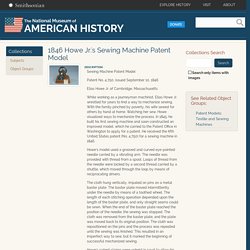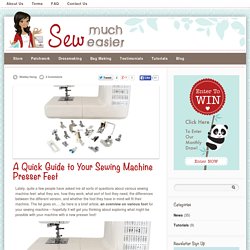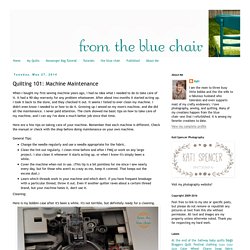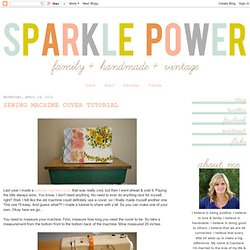

Vintage Sewing Machines Public Group. Just_in_case_you_ever_wonder_how_a_sewing_machine_works-98670. 1846 Howe Jr.'s Sewing Machine Patent Model. Description Sewing Machine Patent Model Patent No. 4,750, issued September 10, 1846 Elias Howe Jr. of Cambridge, Massachusetts While working as a journeyman machinist, Elias Howe Jr. wrestled for years to find a way to mechanize sewing.

With the family pinched by poverty, his wife sewed for others by hand at home. Howe’s model used a grooved and curved eye-pointed needle carried by a vibrating arm. The cloth hung vertically, impaled on pins on a metal baster plate. Howe’s patent claims were upheld in court to allow his claim to control the combination of the eye-pointed needle with a shuttle to form a lockstitch. 5 Unusual Sewing Machine Techniques. Your sewing machine just sews, right?

Wrong! It does so much more! There are some interesting and unusual embroidery techniques you must try out on your machine. Remember to test out on old fabrics! Trial and error is the best way to get to know your machine and how it works. Photos via leighlalovesyou. WeAllSew « A Quick Guide to Your Sewing Machine Presser Feet — Sew Much EasierSew Much Easier. Lately, quite a few people have asked me all sorts of questions about various sewing machine feet: what they are, how they work, what sort of foot they need, the differences between the different version, and whether the foot they have in mind will fit their machine.

Sewing Machine Hook Timing. Vintage Sewing Machine Quilt Patterns. Antique or vintage sewing machines are very popular among today’s quilters and sewers.

The earliest sewing machines, whether they were treadle, hand crank or even the early electric versions seem to capture our hearts. Pattern via Craftsy member Seams to be Sew Ask any quilter if she has an antique sewing machine and her answer will be one of two responses, either “Yes!” Or “I wish I did,” followed by a sigh. Not only do many quilters own a vintage machine, but they use them! Pattern via Craftsy member Brittany Love Why do we love them? Well, there are many reasons. Mug rug pattern via Craftsy member The Patchsmith Another reason we are fascinated with vintage sewing machines is that they bring to mind good memories.
Our mothers, grandmothers, aunts and other family members sewed on them. Organize Your Sewing Room. 5 Unusual Sewing Machine Techniques. From the blue chair: Quilting 101: Machine Maintenance. When I bought my first sewing machine years ago, I had no idea what I needed to do to take care of it.

It had a 90-day warranty for any problem whatsoever. After about two months it started acting up. I took it back to the store, and they checked it out. It seems I failed to ever clean my machine. I didn't even know I needed to or how to do it. Here are a few tips on taking care of your machine. General Tips: Change the needle regularly and use a needle appropriate for the fabric.Clean the lint out regularly. Here is my bobbin case after it's been a while. These are my tools for cleaning my machine.
First lift out all visible lint while vacuuming with a small vacuum. I use canned air to blow out the thread track. Perfect Machine Tension Every Time. Good tension produces a smooth stitch without puckers.

If the top and bottom threads break in exactly the same location, your tension is perfect. The threads may break in more than one place, but the top and bottom threads will both break at that location. Perfect tension causes both threads to break at exactly the same location If only one of the threads breaks, often in more than one location, that thread is too tight. Either slightly loosen that thread, or slightly tighen the other thread. Incorrect tension causes only one thread to break, usually in more than one location. Good sewing machine tension produces smooth, even seams rather than puckered seams, but sometimes it’s hard to determine the adjustments necessary to produce perfect tension. If your tension isn’t right, first make sure that you’ve been timely with the home maintenance your machine requires. If your tension is still off despite a new needle and appropriate thread, try this. ImagesLockstitch. Sewing Machine Cover Tutorial. Last year I made a sewing machine cover that was really cool, but then I went ahead & sold it.

Paying the bills always wins. You know, I don't need anything. No need to ever do anything nice for myself, right? Well, I felt like the old machine could definitely use a cover, so I finally made myself another one. This one I'll keep. 24 Blocks. Quilting Tension Problems: Troubleshooting Tips for Your Machine Have you ever been in the stitching groove, just to see loops or puckers pop up out of nowhere?

It’s often the thread tension that’s causing the frustration, and there are several reasons why it’s causing trouble with your machine. If the thread is too loose or too tight, it affects your ability to make nice, even stitches. To make a definitive diagnosis about the problem, try some of these tips and get your machine back in the groove!
Old Sewing Machine Maintenance. According to the old Singer parts lists, that big spokey wheel on the end of your vintage Singer is the balance wheel.

According to most folks who use a vintage Singer it’s the handwheel, so it’s the handwheel as far as we’re concerned here, and we’ll be looking at its removal and replacement, with a bit of a detour on the way. But why, pray, would anyone want to take the thing off? Well, you could be taking a machine apart because it’s in a disgusting state and cleaning it will be so much easier if you take off some of its bits. Or maybe you want to change the handwheel for a different one? You’re bored and it might be more interesting than cleaning the oven?
“The clutch?” Well, the clutch is what lives behind that big chromed knob in the middle of your handwheel, and without the clutch your machine would be nowhere near as user-friendly as it is. That upping-and-downing is the motion, which you stop by unscrewing the stop motion clamp screw when you want to wind a bobbin.